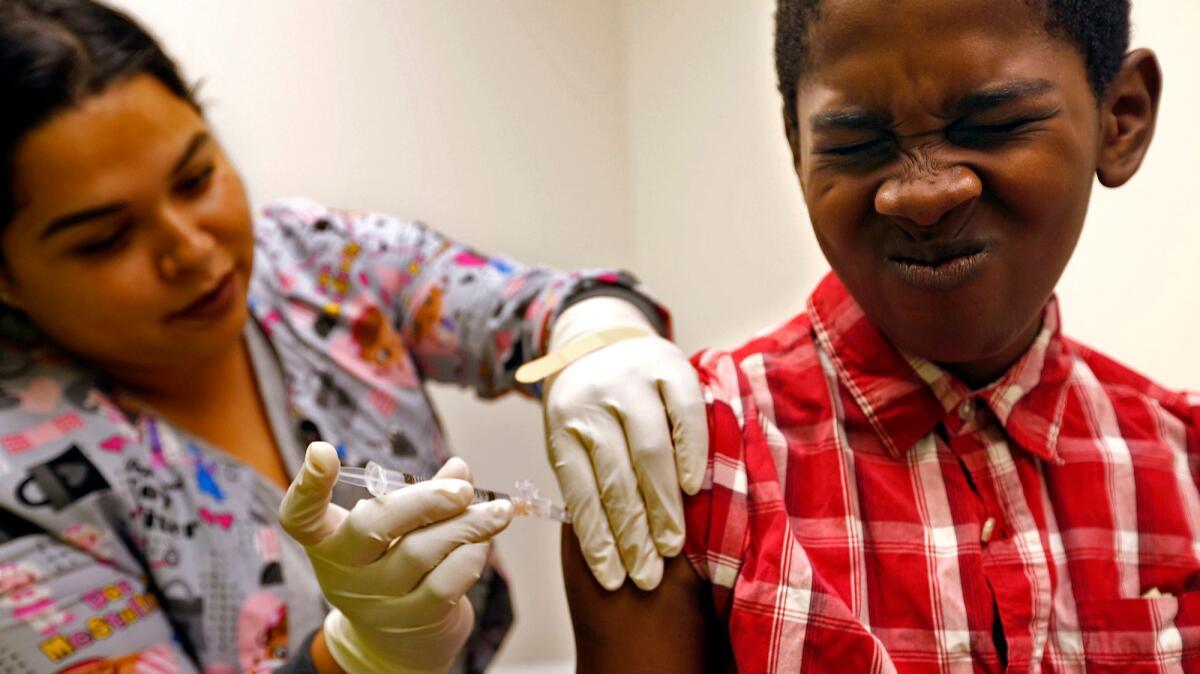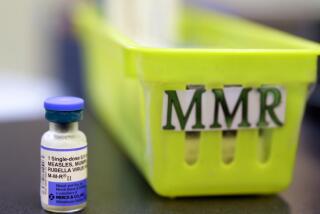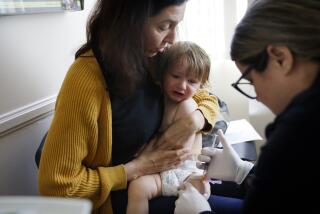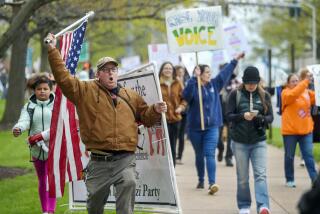After California got rid of personal exemptions for vaccines, medical exemptions went way up

- Share via
The rate of medical exemptions for immunizations for incoming kindergartners rose sharply the year after California eliminated the personal-belief exemption, a new study finds.
The results, published this week in the Journal of the American Medical Assn., hint that some parents who don’t want to vaccinate their children may have found doctors willing to give medical exemptions to students — a potential trend that may undercut the collective protection against contagious diseases that the state law sought to bolster.
When students enroll in school, they’re required to show proof that they were vaccinated against diseases such as polio, chickenpox and measles — dangerous infections that can spread quickly through an unprotected group. Students can be exempted from the vaccine requirement if they have a medical condition that makes immunizations dangerous, such as pediatric cancer or HIV. . In most states, parents also can get exemptions based on personal beliefs.
California Senate Bill 277, passed in 2015, did away with those personal-belief exemptions in the Golden State. The legislation was prompted by a measles outbreak that originated at Disneyland in 2014 and wound up infecting 159 people. That outbreak was likely exacerbated by low vaccination rates, an earlier analysis found.
California’s law sought to remove personal-belief exemptions in order to raise vaccination rates and improve herd immunity, the collective protection provided when the overwhelming majority of people in a group are immune to a disease. Herd immunity helps protect those who, because of medical reasons, cannot be vaccinated and are vulnerable to infections.
But the state law also widened the definition of a medical exemption, allowing doctors to take into account such factors as family medical history.
So SB 277 served as a sort of natural experiment, allowing researchers to see what happened to immunization rates before and after the law went into effect. One question they were eager to answer was this: Would “vaccine-hesitant” parents turn to medical exemptions because they no longer could obtain personal-belief exemptions?
“We were just waiting for the data to be released,” said Paul Delamater, a health geographer at the University of North Carolina at Chapel Hill and lead author of the new report.
For this paper, Delamater and his colleagues tallied the exemption rates before and after the law was enacted. They found that for the two decades before SB 277 went into effect, the percentage of California kindergartners with medical exemptions was mostly stable, generally rising only slightly every few years. For example, in 2005 the rate was 0.15%; in 2015 it was 0.17%.
But from 2015 to 2016, the medical exemption rate jumped from 0.17% to 0.51% — an unprecedented threefold increase in the rate.
The personal-belief exemption rate, by comparison, rose from 1.32% in 2005 to 2.37% in 2015, then fell to 0.56% in 2016, after the bill’s passage. (The rate didn’t fall to zero largely because of children in multiyear transitional kindergarten programs who’d received personal-belief exemptions before 2016.)
The total exemption rate dropped from 2.54% to 1.06%, the researchers found. That’s good news for the law, Delamater pointed out.
However, the researchers wrote, the sudden jump in medical exemptions may be cause for concern, especially because the increase was concentrated in counties that previously had very high rates of personal-belief exemptions.
“Some vaccine-hesitant parents may have successfully located physicians willing to exercise the broader discretion provided by SB 277 for granting [medical exemptions],” the study authors wrote. “If true, this practice would be inconsistent with the recommendation from the American Academy of Pediatrics to reserve [medical exemptions] for children having contraindications.”
Of course, there are some caveats. For one thing, correlation is not causation. For another, perhaps medical exemptions were underused before 2016 even by parents whose children had medical conditions that would make them eligible. After all, personal-belief exemptions were easier to obtain because they didn’t require a sign-off from a doctor.
Still, the results appear to show a worrisome trend — especially since, thanks to the law’s grandfather clause, all students with personal-belief exemptions made for kindergartners before 2016 can continue attending school until they reach seventh grade.
“The increase in the number of [medical exemptions] granted in 2016 further weakens the immediate effect of SB 277 and may limit its long-term benefits if sustained,” the study authors wrote. “Moreover, because the largest increases in [medical exemption] percentage occurred in regions with high past-[personal-belief exemption] use, portions of California may remain susceptible to vaccine-preventable disease outbreaks in the near future.”
The rate of personal-belief exemptions increased by a factor of five between 1996 and 2015. Now that SB 277 has cut off that avenue for vaccine-hesitant California parents, Delamater said he is worried that medical exemptions may also see a similarly steep rise.
“Is this the new thing that’s going to take off over the next 10 to 15 years?” Delamater said. “Because I don’t know if anyone back in 1996, when the personal-beliefs exemption was at 0.46%, could envision what would happen 15 or 20 years later in the state.”
Many questions remain about the effect this complex law may have on vaccination rates, he added. Among the next questions to answer: Do vaccination and exemption rates vary on smaller scales, such as from city to city or school to school? And who are the parents choosing these exemptions?
Ultimately, Delamater said, answering these questions will help officials understand why some parents choose not to vaccinate, and help them to improve vaccine coverage overall.
Follow @aminawrite on Twitter for more science news and “like” Los Angeles Times Science & Health on Facebook.
MORE IN SCIENCE
PSA screening for prostate cancer saves lives after all, study says
After 600 years, astronomers crack the case of an exploding star
UPDATES:
6:25 p.m.: This article was updated with additional comment from Paul Delamater.
This article was originally published at 4:15 p.m.







